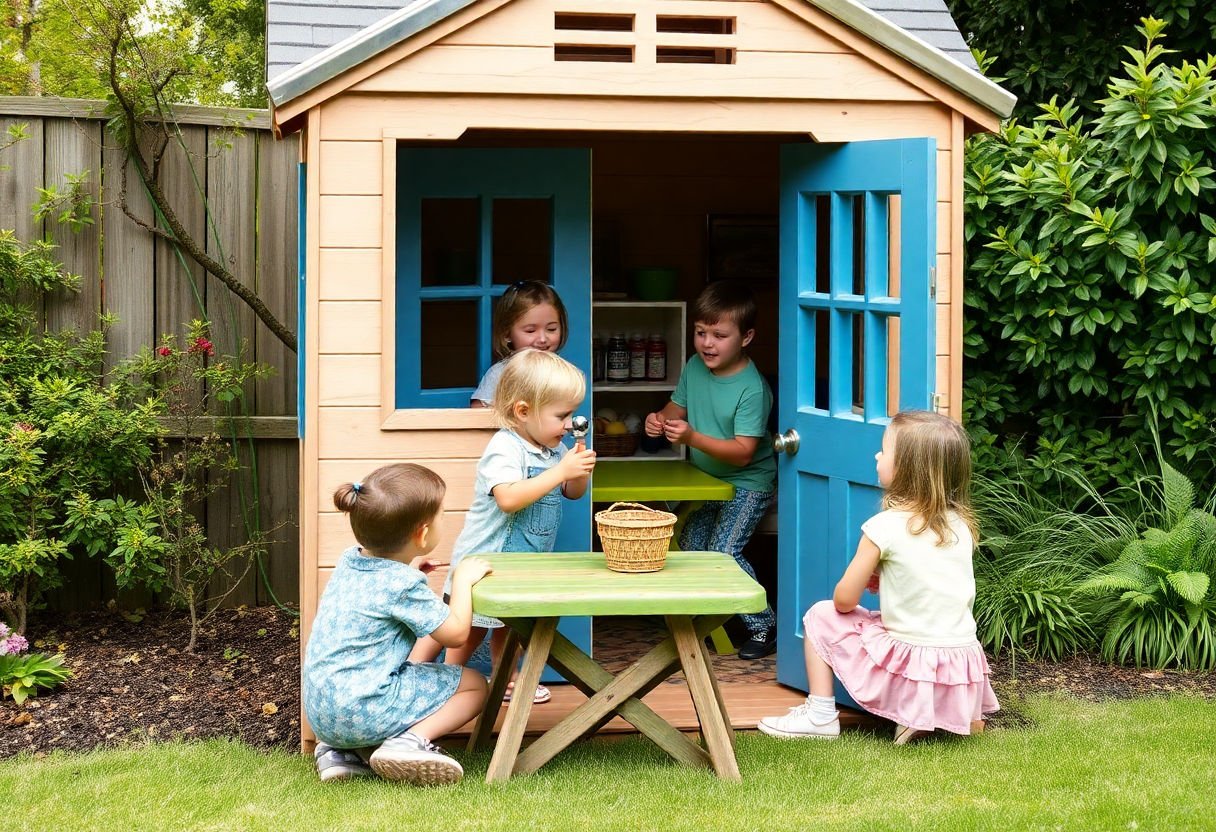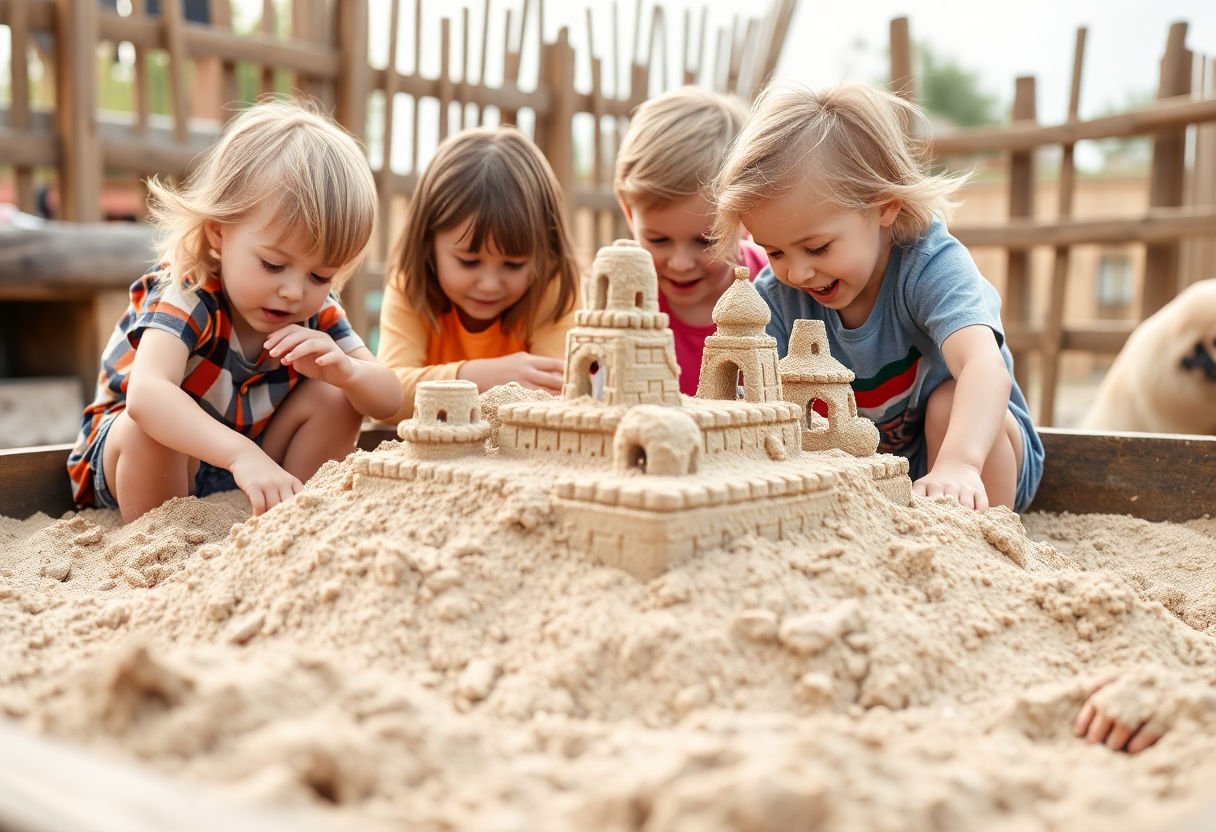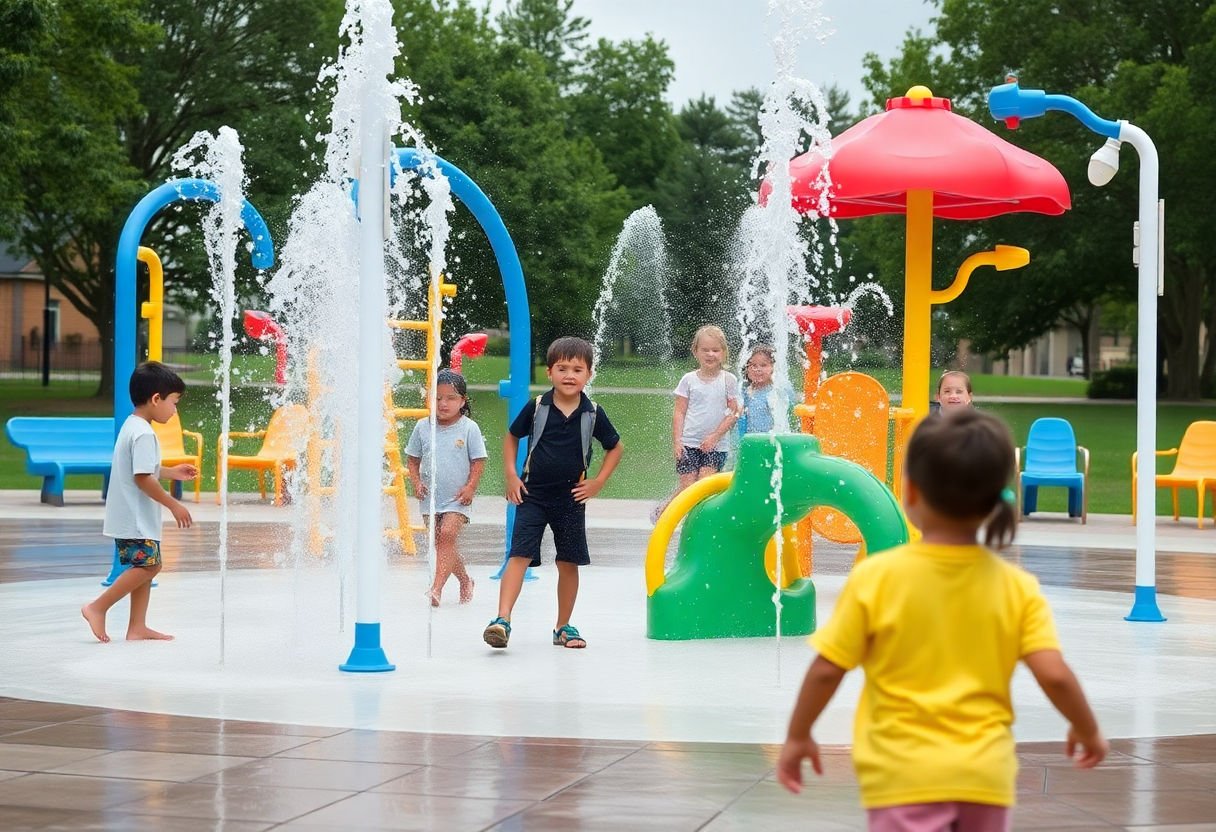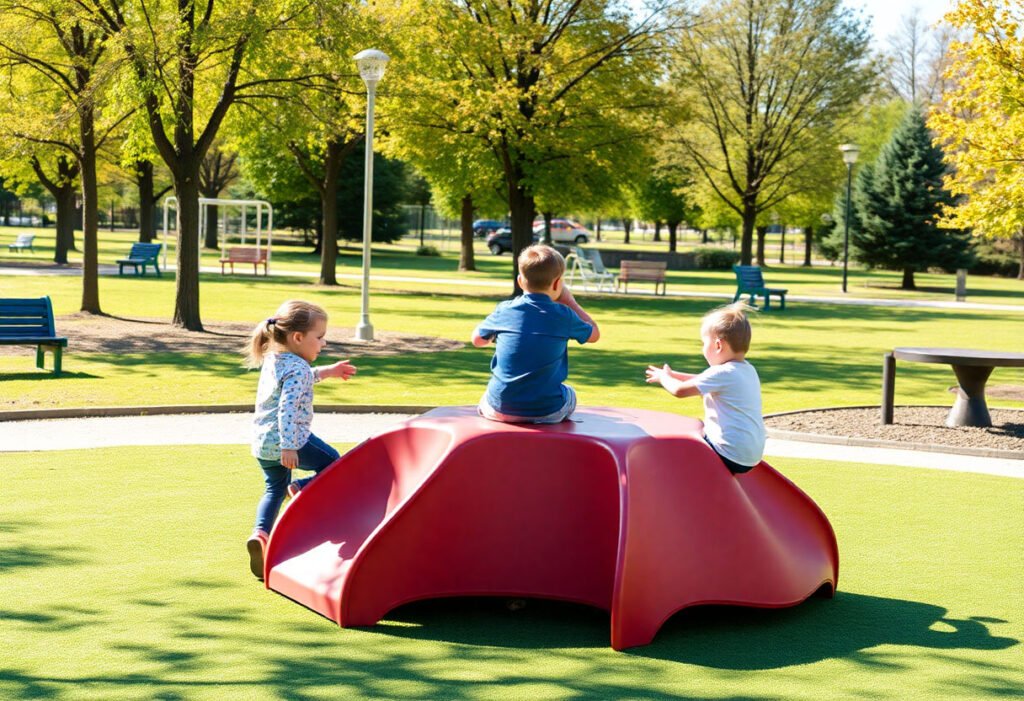The joys of childhood are often rooted in the freedom and creativity found in outdoor play. Engaging with versatile and safe outdoor play equipment is critical for children’s physical and mental development. From swing sets that support core muscle growth to climbing frames that enhance problem-solving abilities, each piece plays a vital role. Whether it’s the thrill of racing down a slide or the creative play sparked by a playhouse, outdoor activities offer numerous developmental benefits. Explore the best options available and how each piece contributes uniquely to a child’s growth, ensuring an enriching playtime experience that fosters imagination and learning.
Key Takeaways
- Outdoor play is essential for children’s physical and mental development, fostering creativity, independence, and problem-solving skills.
- Swing sets and climbing frames significantly enhance sensory integration and physical strength, promoting active play.
- Playhouses and sandboxes ignite imaginative play and creativity, offering endless possibilities for storytelling and exploration.
- Trampolines and bicycles boost fitness and coordination while providing a sense of freedom and adventure.
- Investing in diverse outdoor play equipment supports holistic development in children, ensuring a well-rounded growth experience.
Swing Sets
Swing sets have long been a cornerstone of outdoor play, offering numerous developmental benefits that extend beyond simple amusement. These structures are instrumental in enhancing sensory integration, a crucial aspect of childhood development. The rhythmic motion of swinging provides vestibular stimulation, which helps children develop a sense of balance and spatial orientation. This sensory experience is vital for children with sensory processing disorders, as it assists in calming and organizing their sensory input.
In addition to sensory benefits, swing sets promote core muscle development. The act of pumping legs, gripping chains, and holding onto the swing seat requires the engagement of various muscle groups, particularly the core. Over time, this repetitive motion strengthens abdominal, back, and pelvic muscles, contributing to improved postural stability and endurance. Children who frequently use swing sets often demonstrate enhanced coordination and physical strength, which are foundational skills for other physical activities and sports.
Moreover, swing sets encourage outdoor play, which is essential for overall physical health. By providing an engaging outdoor activity, swing sets incentivize children to spend more time outside, reducing screen time and promoting healthier lifestyle habits. Parents and educators can foster social skills as swing sets are often a focal point for group play, teaching children vital lessons in sharing, taking turns, and cooperative play.
In conclusion, swing sets are not just an amusement; they are an investment in a child’s physical and sensory development. By facilitating these experiences, swing sets play an integral role in unleashing a child’s imagination and enhancing their developmental journey.
Climbing Frames
Climbing frames are quintessential in enhancing a child’s developmental journey, providing both physical and cognitive benefits. These structures offer a dynamic playground that goes beyond mere recreation, serving as a crucible for problem-solving skills. As children navigate different paths, they learn to assess risks, make decisions, and devise strategies—skills that are critical throughout life.
Physically, climbing frames are excellent for building strength and coordination. They challenge various muscle groups, fostering upper body strength, agility, and balance. Climbing also demands higher cardiovascular engagement, contributing significantly to overall physical fitness. This holistic approach to exercise helps in the development of strong bones and muscles while promoting a healthy, active lifestyle.
Moreover, climbing frames stimulate neurological development. The act of climbing involves integrating sensory information, hand-eye coordination, and spatial awareness. Thus, these frames are not only physical challenges but also serve as complex puzzles that stimulate a child’s mind.
In addition, climbing frames inevitably encourage social interaction. They provide an ideal setting for teamwork and cooperation as children may attempt obstacles together, practice turn-taking, and learn to support one another. This fosters a sense of camaraderie and builds valuable social skills.
Overall, incorporating climbing frames into outdoor play environments furnishes children with rich learning experiences. As they swing, balance, and climb, they engage in a multifaceted activity that nurtures both the body and the mind, preparing them for the challenges of everyday life. In essence, climbing frames are a stellar investment in nurturing resilient, capable, and socially adept individuals.
Slides

Slides provide both a thrilling experience and substantial developmental benefits for children engaged in outdoor play. These playground staples are cherished for their ability to offer a sense of adventure while simultaneously fostering physical and cognitive growth.
One of the primary advantages of incorporating slides into outdoor play is their ability to enhance gross motor skills. As children climb up the ladder and maneuver down the slide, they are actively engaging muscles in their legs, arms, and core, which contributes to their overall physical development. The repetitive climbing and sliding action also aids in improving balance and coordination, as children learn to navigate the equipment safely.
In addition to physical benefits, slides also serve as a tool for social interaction and turn-taking skills. Children often find themselves negotiating turn order and assisting one another during play, which fosters communication and teamwork. This aspect of play is particularly valuable as it helps children develop essential social skills necessary for lifelong success.
Beyond physical and social benefits, slides offer a unique sensory experience. The tactile sensation of various slide materials, the sight of the landscape from an elevated height, and the sound of the wind rushing past heighten sensory awareness, all while providing an exhilarating rush that many children find irresistible.
Moreover, the versatility of slides is worth noting. Available in myriad designs—from straight and wave slides to spiral and tunnel variations—they can be adapted to suit diverse age groups and developmental needs. Such adaptability allows for a personalized play experience, enriching outdoor activities and ensuring that every child finds enjoyment and growth.
Playhouses

Outdoor playhouses serve as a gateway to imaginative play, offering children a dedicated space where creativity flourishes. These mini-structures, often styled like charming cottages or adventurous forts, foster an environment where young minds can envision countless scenarios—from running a bustling café to leading a woodland expedition.
The cognitive benefits of playhouses are notable. Engaging in imaginative play can significantly enhance problem-solving skills, as children navigate social roles and create intricate storylines. Playhouses also promote language development as kids invent dialogues and narratives, often involving peers in complex conversations enriched by new vocabulary.
Moreover, playhouses provide a unique setting for developing social skills. Children engage in cooperative play, learning essential skills such as sharing, negotiation, and conflict resolution. This environment encourages friendships, boosting social confidence and emotional intelligence.
Physically, navigating the confines and features of a playhouse supports gross motor development. Movements like crouching, bending, and reaching enhance muscle coordination and balance. Some playhouses include additional features such as slides or climbing walls, further promoting physical fitness.
In addition to individual benefits, playhouses offer a safe outdoor space for children to explore. Parents can rest assured as these structures typically adhere to safety standards, ensuring sturdy design and non-toxic materials. Thus, playhouses not only unlock imaginative worlds but also provide a practical, secure play option, empowering children to dream, explore, and learn.
Trampolines
Trampolines are a staple in many American backyards, offering an exhilarating blend of fun and physical activity. They provide an excellent opportunity for children to engage in vigorous exercise while simultaneously developing coordination and balance. The dynamic nature of a trampoline encourages cardiovascular health and burns energy, making it particularly beneficial for children brimming with enthusiasm.
A significant advantage of trampolines is their ability to enhance a child’s sense of proprioception, or the awareness of body alignment and space. This is crucial for developing skills applicable to various sports and physical activities. Jumping on a trampoline promotes the strengthening of core muscles and improves posture, fostering a sense of body control that can be particularly supportive in other areas of physical development.
From a fitness perspective, trampolines offer a fun-filled way to maintain a healthy lifestyle. According to some health experts, just ten minutes of bouncing can equate to a half-hour jog, making them an efficient option for physical fitness. Moreover, the enjoyment derived from trampoline jumping encourages children to engage willingly with exercise, associating it with pleasure rather than obligation.
Safety, however, remains a primary concern for parents considering trampolines. Ensuring the trampoline is equipped with safety nets and placed on even ground can mitigate the risk of injuries. Teaching children proper jumping techniques and enforcing rules about safe usage can also contribute to a secure play environment.
In conclusion, trampolines are more than just fun; they serve as a powerful tool in promoting health and fitness, developing crucial physical skills, and stimulating a child’s zest for outdoor play.
Bicycles and Scooters

Bicycles and scooters serve as a quintessential gateway to adventure for children, fostering both coordination and a sense of independence. Riding a bicycle or scooter requires children to develop their balance, coordination, and physical strength. This not only enhances their motor skills but also contributes to overall physical fitness. Encouraging children to navigate their surroundings on bikes or scooters can significantly improve their spatial awareness and cognitive mapping abilities.
One of the most compelling benefits of bicycles and scooters is the promotion of independence. These vehicles allow children to travel short distances on their own, instilling a sense of responsibility. They learn to follow routes, adhere to basic safety rules, and make quick decisions, which are critical skills in their development.
Here’s how bicycles and scooters support child development:
- Balance and Coordination: Constant practice of maintaining balance on two wheels aids in developing core stability and coordination.
- Fitness and Health: Regular riding improves cardiovascular health and builds stamina.
- Social Skills and Confidence: Riding in groups or with family can boost social interaction and confidence in new environments.
In the words of a parenting expert, “Bicycles and scooters offer a perfect blend of fun and physical activity, encouraging children to explore the world around them confidently.”
Introducing bicycles and scooters into a child’s play routine not only promotes health benefits but also supports psychological growth by nurturing a sense of adventure and autonomy. Offering children the opportunity to ride empowers them to take charge of their explorations, paving the way for numerous developmental milestones.
Sandboxes

Sandboxes offer a unique playground experience that fosters sensory exploration and boosts creativity. Through the tactile engagement with sand, children can enjoy a tranquil and imaginative playtime that is both educational and therapeutic. The shifting textures and coolness of sand stimulate children’s senses, making them more aware of their surroundings in a natural and calming way.
Engaging with a sandbox allows children to cultivate their creativity and cognitive skills in numerous ways. Whether they are constructing elaborate sandcastles or designing intricate roadways for toy cars, sand play encourages them to think critically and plan strategically. This type of play can enhance problem-solving abilities and boost spatial awareness as children learn to navigate and manipulate their environment.
Additionally, sandboxes serve as a perfect setting for social interaction. In group play scenarios, children must collaborate, negotiate roles, and devise plans together, which strengthens their communication and teamwork skills. These interactions teach patience, sharing, and cooperation, all essential traits for social development.
Furthermore, sand play is a fantastic medium for physical development. Digging, scooping, and building sand structures involve the use of fine motor skills and hand-eye coordination. These activities strengthen small muscles in the hands and fingers, aiding overall dexterity and preparing children for future tasks that require precise hand movements.
In conclusion, sandboxes provide a holistic developmental opportunity that is as entertaining as it is educational. They serve as a sanctuary for young minds to explore, imagine, and grow while enjoying the freedom of outdoor play.
Water Play Structures

Water play structures are an essential component of outdoor play areas, offering a wealth of developmental benefits for children. These structures encourage exploratory play, which can significantly enhance a child’s creativity and cognitive development. The tactile experience of running water stimulates the senses, providing an ideal environment for sensory learning.
One of the most significant benefits of water play is its ability to foster social skills. Children naturally gravitate towards interactive play, and water structures offer numerous opportunities for collaborative activities. Whether it’s building waterways, floating objects, or engaging in water games, these activities inherently teach teamwork, sharing, and communication.
Moreover, water play structures can introduce basic scientific concepts. Children become mini-experimenters as they observe the flow of water, learn about buoyancy, and understand the concept of cause and effect. This type of play also nurtures problem-solving skills as kids devise new ways to manipulate and control the water flow.
From a physical standpoint, engaging with water play structures helps develop fine and gross motor skills. Actions such as pouring, squirting, and splashing involve the coordination of various muscle groups. These activities not only strengthen fingers and hands but also promote overall muscular development.
In addition, water play provides a refreshing retreat on hot days, making it an attractive feature for families seeking outdoor activities. Enhancing an outdoor play area with water structures thus provides children with a multifaceted learning environment that is both entertaining and educational. These benefits underscore the importance of integrating water play into children’s outdoor playtime, offering a dynamic platform for growth and imagination.
Conclusion
Investing in quality outdoor play equipment is essential for fostering children’s development. Such equipment enhances physical strength, sensory integration, and imaginative play, while promoting skills like problem-solving and coordination. As society increasingly shifts indoors, ensuring children have engaging outdoor play experiences becomes paramount. By embracing these enriching play options, we not only support current generations but lay the groundwork for healthier, more balanced future ones. Encourage your child to explore various types of outdoor equipment, as it enriches their growth and imbues them with lifelong benefits well beyond playtime.
Frequently Asked Questions
What should I consider when choosing outdoor play equipment for my child?
When selecting outdoor play equipment, prioritize safety features, age-appropriateness, and durability. Consider your child’s interests and developmental needs to ensure the equipment supports both imaginative play and physical development.
How can I ensure the safety of outdoor play equipment?
Regular maintenance and inspections are crucial for safety. Ensure the equipment is installed on appropriate surfaces, such as soft ground materials, and always supervise children during play to prevent accidents.
Is outdoor play equipment worth the investment?
Investing in quality outdoor play equipment can significantly benefit children’s physical, social, and cognitive development. The right equipment enhances imagination and contributes to an active lifestyle.
At what age can children start using outdoor play equipment?
Most outdoor play equipment is designed for children aged three and above. However, always check the manufacturer’s specifications for age recommendations to ensure safety and compatibility.
How can outdoor play equipment promote imaginative play?
Outdoor play equipment like playhouses and sandboxes encourages children to create their own adventures. These setups allow kids to engage in role-playing and storytelling, stimulating creativity and imagination.


